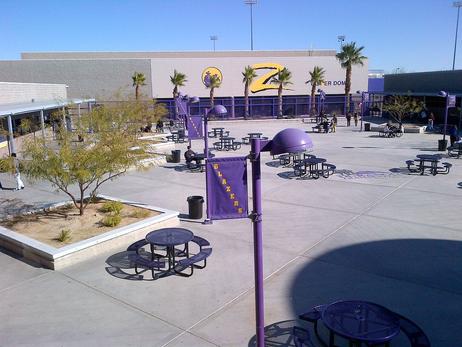The Clark County School District, which encompasses all of Clark County in Nevada, is one of the largest school districts in the United States today. The district includes the city of Las Vegas, as well as North Las Vegas, Mesquite, and Henderson. The district is made up of seven different regions, which includes all of the public schools in the county, as well as a number of alternative schools and a handful of charters.
The History of Clark County School District
Clark County School District was first established in 1956, according to Wikipedia. At that time, the Nevada legislature consolidated state districts into the county district, giving Clark County a single school district rather than the 14 divisions of districts it had held prior to that decision. At the time Clark County School District was established, it boasted an enrollment of right around 20,000 students. Today, the district is home to more than 300,000 and 15,000 teachers.
Much of the growth in Clark County occurred between the last decade of the 20th century and the first few years of the current century. Growth can be attributed to the rapid development in Las Vegas, which brought many more families into the area. Voters in Nevada had to approve a number of bond issues during this time to accommodate the rapid growth and ensure the school system was able to keep up with the enrollment increases. There was also a high demand for teachers during this time. The recent recession has slowed the growth of Las Vegas and Clark County somewhat, but accompanying budget cuts presented their own challenges.
Governance of Clark County School District
Clark County School District is overseen by a seven-member board of trustees, according to the Las Vegas Sun. Each trustee represents a specific region of the district and is elected by district residents for a four-year term. The board is responsible for guiding the superintendent for the county, as well as making policy decisions, setting budgets and handling other governance responsibilities. The trustees meet twice a month and meetings are open to the general public. One parent advisory meeting is also held each month.
Currently, the superintendent for the Clark County School District is Dwight D. Jones. Jones was appointed by the Board of Trustees in November 2010. He serves as the chief executive officer for the district and works closely with trustees on various school-related matters. The board also elects its own president and vice president. The rest of the trustees represent a specific area of the county during their staggered, four-year terms.
The superintendent and board are responsible for managing an annual budget of more than $3 billion. This calculated out to approximately $6,800 per student during the 2008-2009 school year, a figure that grew slightly from the previous school year. Despite sufficient spending per student, the schools in Clark County have failed to perform satisfactorily, with high dropout rates and low completion rates a constant reminder that the district is failing a large percentage of its students.
Achievement and Performance in Clark County School District
According to the Las Vegas Sun, graduation rates in Clark County School District are “abysmal,” hovering at around 63 percent. The drop-out rate is also one of the worst in the nation. A small percentage of the more than 330 schools in the county make Annual Yearly Progress during each academic year. However, the numbers do appear to be improving, as educators in the state work to bring the Nevada public school system on par with others in the country.
The district does offer a gifted and talented program for students in elementary grades. The district also offers a variety of magnet schools, which offer alternative curriculum options in a challenging, innovative environment. Clark County School District provides a number of career and technical education options, as well as specialized education in fields like aerospace, performing arts, and law. Some schools have also developed interactive learning environments for students, including a rainforest and a mock space shuttle.
Clark County School District Services
Food service programs began in Clark County in the 1960s, according to the Clark County website. Prior to that time, students were able to walk home from school during their lunch hour. When bussing became more common, lunches needed to be provided at school for students who could not make it home over the lunch period. Lunches began as cold sandwiches since schools did not offer any facilities for warming food. Today, most elementary schools still ship breakfasts and lunches daily. Some middle and high schools have full-service kitchens that prepare two or three meal selections for students every day.
Clark County School District also boasts its own law enforcement department. The police department started in the 1960s as a branch of the Maintenance Department, but today, this department is an autonomous office with employees who are able to make arrests and issue traffic violations. According to the district website, the mission of the police department for the school district is to provide a “safe, secure and nurturing learning environment.”
The Clark County School District is one of the largest and most established school districts in the country. With a diverse student base and a large area to cover, this district has seen more than its share of challenges. However, new programs are constantly introduced and new schools are established to help the diverse student community in this region see academic success within the confines of the state of Nevada.
Questions? Contact us on Facebook. @publicschoolreview












